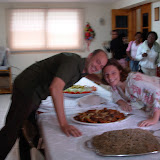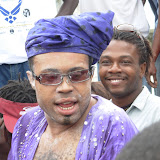Imagine a U.S. prison big and crowded enough to hold about half of the country's prisoners. Now imagine that it was built just a couple of blocks away from the white house. Imagine that there was one day every year when the highest ranking officials of the prison and justice systems, along with a bunch of journalists and human rights activists, sat down together on one side of the main prison yard under a big tent. Across the aisle from these civilians was a corresponding number of prisoners, selected to represent all of the inmates. Imagine a religious service held there in the prison yard that emphasized the dignity and worth of all prisoners, stating in no uncertain terms that they were no different from anyone else, and that all free people would be judged for every injustice suffered by those incarcerated people. Then, imagine representatives of the government taking turns speaking to the crowd, doing their best to provide explanations for the problems of the criminal justice system. And finally, imagine that the prisoners themselves were then able to send their own representatives up front to say whatever they want, no matter how angry or inflammatory.
This was the scene, more or less last Sunday, and it was quite remarkable. The shame of the officials and the anger of the prisoners was not without reason. The prisons here are hellish. International treaties on prisoners' rights declare that each prisoner should have at least 4.5 square meters of space to themselves. In Port-au-Prince's National Penitentiary, as in most of Haiti's prisons, the actual figure is less than a square meter per inmate. The prisoners are packed in their cells worse than sardines; they have to sleep in shifts because there is not enough room for everyone to lie down on the floor at once. Many suffer from tuberculosis, HIV/AIDS, beriberi (vitamin B deficiency), contagious itchy rashes, and other sicknesses which are impossible to contain in such overtaxed conditions.
Only a tiny fraction of the inmates have even been convicted of any crime. In Haiti it is legal to lock someone up once they have appeared before a judge to learn what crimes are being brought against them. But after that time, they are not supposed to spend more than two months in prison before going to trial. Of course, the vast majority of the prisoners at the National Penitentiary have been there for at least two months - some longer than two years - without yet going to trial. The reasons for this include corruption, gross incompetence, and a plain lack of resources on the part of the justice system.
Still, all told, I was impressed by the courage of the state authorities to acknowledge these problems, and the courage of the inmates to speak out against them, demand better treatment, and continue to hope that a better future is possible. The Haitian government is the author of many -- NOT all, but many -- of it's own troubles. But on this one occasion, you have to give them points for humility.
Special mass for the prisoners:
At times the priest's voice was drowned out by prisoners chanting in anger from their cells. It was a painful reminder that we all might be equal in God's eyes, but that spiritual reality means precious little to these miserable detainees.
Here's one of the prisoners speaking to the audience.
He was calm and dignified, but his words were heavy with determined, righteous anger.
The director of the penitentiary authority:
I've actually met with this man before. He's a giant. He is also a very serious and somber man, who I dare say feels real compassion for the prisoners that have been put under his charge. More than you can say for many of the wardens of individual prisons around the country.
The director presenting trophies to the soccer teams that won the tournament they played on the prison yard concrete.
There were also awards given to the winners of the dominos and checkers competitions. All of the winners were given the microphone to make a victory speech. And every one of them opted instead to denounce their conditions, demand justice, or mourn fellow inmates who had died.
Finally we were given a tour of the prison from the top of the wall that surrounds the complex. Here's some of what I saw:
How do you feed three thousand prisoners?
Surely this was made special for International Prisoners' Day -- the rice doesn't usually have beans in it. And even on this day, the beans were pretty skimpy by Haitian standards.
Wednesday was a fairly significant milestone. It marked my 365th day in Haiti, as well as my 30th birthday. I had a party at my office for lunch, along with Stephanie from Belgium, who's birthday was on the 30th. Then that evening I had my fellow MCCers and Remi over to my house, where my landlady/Haitian mother cooked an amazing, all local feast for us. Photos here:
 |
| Birthday 2007 |
I was kind of lazy and didn't write any captions. Remi did a better job on her album here.
I've heard several Haitians refer to a folk belief they have, that if a person isn't married by age 30, they will never be married at all. So all day on Wednesday, my Haitian coworkers were wishing me a happy birthday and promising to find me a nice wife, or telling me that they'd be praying for the right woman to find me. Even Russa, my Haitian mother, true to her role, gave me a big talk about how she was just sure that this year I would meet that special someone. Then she said something that my own mother definitely would not have included: "Because, Felix, I don't have to tell you that there are all kinds of dangerous diseases out there like AIDS and what not."
Uhhh, right. I'm not too worried about getting AIDS, so this wasn't a big selling point for marriage. I'm not one for superstition, either. But for all those women out there who are, I've got two words for you: last chance. Just one year to go! Start your engines! Fly, row, swim, do whatever you need to do to get to this island if you want a shot to be Mrs. Felix. Because if this fish gets away before Halloween 2008, he's gone for good!
I'll alert the coast guard to prepare for the major spike in immigration to Haiti.
* * *
Finally, I wanted to share some photos and video from the Gede celebrations. two Saturdays ago I went to a seminar on the celebrations that occur within Vodou every November 1st and 2nd. These are national holidays, and they focus on a class of Vodou spirits known as the Gede, who are the mediators of the life and death cycle. Chief among them is a figure known as Baron Samedi - sometimes depicted as a black man, sometimes as a skeleton, but always wearing a black suit and top hat.
One of my coworkers invited me to go with him to the Port-au-Prince cemetary -- the Gede ground zero -- on the morning of November 1st. The colors of Gede are black, white and purple, as you'll notice. The video Dafus and I took below is pretty rough, and I didn't edit it at all. I'm leaving it in its entirety for those of you who are really curious. First you'll see us approaching a crowd gathered around the black cross of Baron Samedi, where people are lighting candles and offering prayers and pouring out sacrifices of rum. Then, you'll see a couple of men dressed in purple and black approach from far away while the crowd makes a hubbub. There's some debate whether these men were actually gay or only pretending to be gay, but everyone started chanting right away men masisi!, which is a somewhat vulgar way of saying "here come the homosexuals."
Homosexuals live very secret lives in Haiti because public persecution can be very serious, but there was a certain tolerance on this occasion. There was also a lot of tolerance for taking photos. Normally, snapping close photos without permission can get you roughed up in Haiti, but people weren't bothered at all when Dafus and I were snapping shots or taking video.
After the scene by the Baron Samedi cross, you'll see some panning footage of the cemetary chapel as well as the tall, New Orleans-style graves. In Haiti, the graves are almost always these above ground plots for stacking caskets, or they are shaped like little houses. you'll be able to pick out a couple of those in the video too.
Finally, you'll see a crowd of people dressed all in white, chanting and singing. These are a bunch of new initiates into the Vodou priesthood. There's a lot more I could write about the things I saw there, but I don't even know where to start. Feel free to send questions, and I'll try and answer them.
Here's the video:
Here's some photos:
 |
| Gede |
